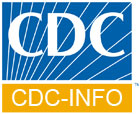Skip directly to the search box, site navigation, or content.
Division of Foodborne, Bacterial and Mycotic Diseases (DFBMD)
Coccidioidomycosis
Clinical Features
Symptomatic infection (40% of cases) usually presents as flu-like illness with fever, cough, headaches, rash, and myalgias. Some patients fail to recover and develop chronic pulmonary infection or widespread disseminated infection (affecting meninges, soft tissues, joints, and bone). Severe disease may develop in HIV-infected persons or others with weakened immune systems, people receiving corticosteroids, and pregnant women. People of African, Asian or Filipino descent may also be at increased risk for disseminated disease.
Etiologic Agent
Coccidioides immitis (typically found in California) and Coccidioides posadasii (typically found in Arizona).
Resovoir
Soil in semiarid areas (primarily in the Lower Sonoran life zone). Endemic in the south-western United States, parts of Mexico and South America.
Incidence
Incidence appears to have increased in Arizona over the past decade. Incidence in 2006 was was 91 cases per 100,000 population. Of persons living in areas with endemic disease, 10-50% are skin-test positive.
Sequelae
In people who develop progressive, chronic or disseminated disease, symptoms may persist for months or even longer. Meningitis may lead to permanent neurologic damage. Mortality is high in HIV-infected persons with diffuse lung disease.
Transmission
Inhalation of airborne arthroconidia after disturbance of contaminated soil by humans or natural disasters (e.g., dust storms and earthquakes).
Risk Groups
Persons in areas with endemic disease who have occupations exposing them to dust (e.g., construction or agricultural workers, and archeologists). Military trainees participating in training exercises in endemic areas also at risk. Groups at high risk for disseminated disease are African-Americans and Asians, people of Filipino descent, pregnant women during the third trimester, and immunocompromised persons.
Surveillance
National surveillance through NETSS started in 1995. Reportable in some states with endemic disease: California, New Mexico, Arizona,and Nevada.
Challenges
Developing an effective vaccine (vaccination offers the best prevention measure because infection provides life-long immunity). Identifying factors associated with increased risk for dissemination in select racial groups to target prevention efforts. Determining factors associated with increasing incidence in endemic areas. Determining influence of climate change.
Content Source: National Center for Zoonotic, Vector-Borne, and Enteric Diseases (ZVED)
Program Contents
Contact Information

